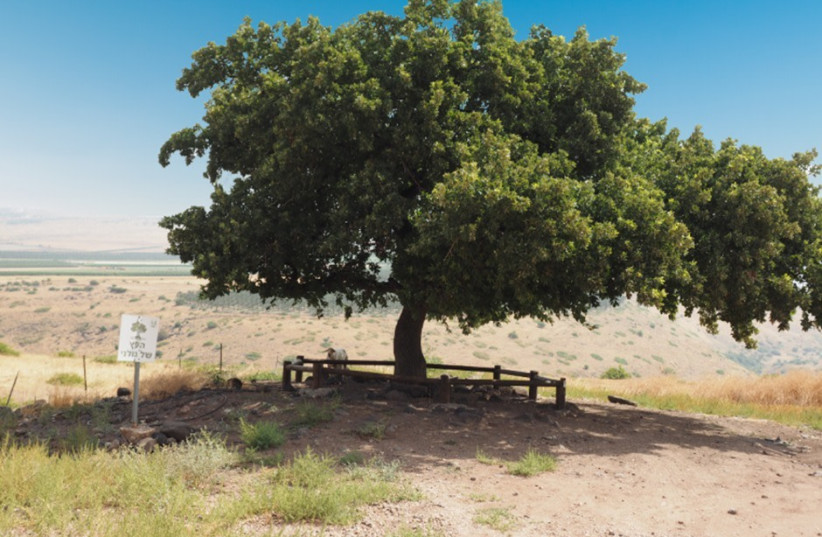Naomi Tzur, chairwoman of the Sustainable Jerusalem lobby, once noted that trees in Jerusalem are not just an academic or public issue; aged trees have historical, cultural and scenic value. Yet, once again, trees are being sacrificed by the authorities, even when experts argue that there is no need.
A recent case occurred a few weeks ago, when the municipality decided to uproot an ancient (120-year-old!) eucalyptus tree in Yemin Moshe, claiming that the tree was sick. Environmental activists expressed their opposition and maintained that the tree could be cured. As for the danger of its collapse, the activists say that it is the municipality’s responsibility to prevent injury by fencing the tree and warning passersby.
This is one specific case, but activists for the preservation of trees in the city, who encourage the planting of new trees throughout the city, claim that the situation is bad. They are insisting that the authorities – in this case, the municipality, which has its own official forestry officer – should do more about it. Too many trees are cut down and uprooted without taking into account their chance to survive or be relocated, which occurs when roadwork is being done.
Too many questions have remained, without satisfying answers, regarding who is profiting when trees are cut down.
Moreover, there is no comprehensive plan for the conservation of aging trees. In most cases, the only care given to a mature tree is to prune it. There are almost no budgets for complex treatments to protect trees from pests or for fertilization and orthopedic treatments, such as branch and trunk support. The result is that sometimes the condition of the aging trees deteriorates even before it is decided to cut the trees down.

OFFICIAL ESTIMATES note that there are about 150,000 trees located in the city’s public areas. However, an exact figure is not readily available. According to activists and nature experts, a large number of these trees are under danger to be felled or are so neglected that there is no option except to uproot them.
But that doesn’t have to be the situation. Today, the benefits of trees are widely acknowledged. For instance, Brazilians who replanted over 2.5 million trees in 20 years managed to bring back about 172 species of birds, as well as 33 species of mammals, 15 species of reptiles, and 15 species of amphibians.
There have been some changes by the city. For instance, the municipality decided that a permit is required to fell a protected tree or mature tree. However, activists argue that the procedures and reality do not necessarily match. There are too many cases in which the municipality has uprooted trees – without the public’s full input, such as the case of the eucalyptus tree in Yemin Moshe.
In this instance, forestry officials issued a logging permit immediately. According to Ossi Benjamin, a tree preservation activist, the permit was valid on the same day the application was submitted (July 4, 2022) without the publication of public objections on the website, 14 days before entry into force.
Moreover, the forestry official wanted to cut the tree down, since it was in danger of collapsing, and issued a felling permit immediately. However, no professional survey was done, and no professional plan was made to treat the tree, as required. Therefore, it is clear that the felling permit was illegal and should have been canceled immediately.
“A 120-year-old eucalyptus tree, a historic tree [that should have] strict preservation, is worthy of care, professional pruning, supervision and quality management,” Benjamin wrote. The Yemin Moshe residents have asked for a clarification from the mayor, yet no response has been given.
But what are the rules? According to the forestry ordinance, a protected tree can be an olive tree, a carob tree, or a protected tree that appears on the forestry’s updated list.
“The most important issue here is to share all the knowledge with the residents and avoid making any significant decision before informing the residents,” a Yemin Moshe resident said. ❖
<br>Municipal response
A municipality spokesman informed In Jerusalem that in 2021, 4,377 trees were cut down for various reasons, such as if they were diseased or dead, if there was a road safety issue, or if there were construction considerations. About 8,000 new trees were planted that year.
The plan for 2022 is to plant another 10,000 trees, at the end of the shmita year. Any tree felling, whether on private or public land, requires prior approval by forestry officials at the Agriculture Ministry, as well as the provision of landscape compensation by the contractor which corresponds to the monetary value of the trees that were cut down.
